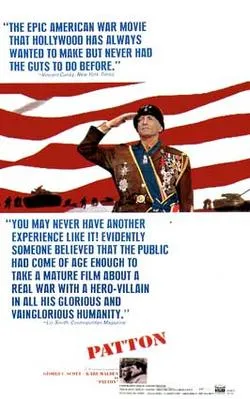Historical accuracy of Patton

Historical accuracy of Patton

Characters
General George S. Patton Jr.
George C. Scott's portrayal captures Patton's known personality traits, famous speeches (composited), and historical actions. However, internal monologues and motivations are interpretive drama, not documented fact.
General Omar N. Bradley
Bradley served as narrator and consultant, so the portrayal reflects his perspective. It captures his contrasting style but simplifies their complex, sometimes strained relationship.
General Bernard Montgomery
Montgomery's cautious reputation and rivalry with Patton are depicted, aligning with historical perception, though perhaps exaggerated for dramatic contrast.
Field Marshal Erwin Rommel
Rommel is portrayed as Patton's respected foe, primarily shown through reputation and the impact of battles, which aligns with his historical role and Patton's view of him.
General Walter Bedell Smith
Smith's role in delivering difficult orders and reprimands from Eisenhower to Patton is accurately portrayed based on historical accounts.
General Dwight D. Eisenhower
Eisenhower's ultimate authority over Patton and his role in managing Patton's controversies (like the slapping incidents) are accurately represented, though he has limited screen time.
More characters
Captain Oskar Steiger
Steiger and his scenes are entirely fictional, created as a narrative device to provide exposition about German perspectives and enhance Patton's mystique as a feared commander.
Sergeant William Meeks
Likely a fictional composite character representing the various drivers and aides who served Patton, used for dialogue and to humanize the general.
General Lucian K. Truscott
Truscott did assume command of troops previously under Patton during the Sicily campaign after Patton moved towards Messina.
Field Marshal Harold Alexander
Alexander was the Army Group commander attempting to coordinate the efforts of his often-rivalrous subordinates, Patton and Montgomery.
Colonel General Alfred Jodl
Jodl is accurately depicted in the German high command reacting (incorrectly) to Allied deception plans which involved Patton's 'ghost army'.
Story
Opening speech in front of American flag
Iconic scene, but the speech is a composite of several actual speeches Patton gave, condensed and cleaned up for cinematic effect. The setting (just the flag) is stylized.
Patton takes command / restores discipline in North Africa
Patton was sent to command US II Corps after the defeat at Kasserine Pass and quickly implemented strict discipline and training reforms.
Rivalry with Montgomery (North Africa, Sicily)
Patton and Montgomery had a well-documented professional rivalry, often competing for resources and glory, particularly evident during the Sicilian campaign.
Invasion of Sicily and race to capture Messina
Patton led the US Seventh Army in Sicily and famously pushed hard to capture Messina ahead of Montgomery's Eighth Army.
The slapping incidents involving two soldiers
Patton did slap and verbally abuse two different soldiers suffering from battle fatigue ("shell shock") in field hospitals in Sicily, incidents which caused a major controversy.
Eisenhower demands apologies / Patton sidelined
Eisenhower severely reprimanded Patton, forced him to apologize publicly to the troops involved and others, and subsequently relieved him of command of the Seventh Army, sidelining him for months.
Patton used as decoy for D-Day (Operation Fortitude / FUSAG)
Patton was given command of the fictional First US Army Group (FUSAG) in England as part of a successful deception plan to convince the Germans the main Allied invasion would target Pas-de-Calais.
Command of Third Army / Rapid advance across France
Patton was given command of the US Third Army after D-Day and led a famously rapid armored advance across France.
Relief of Bastogne during Battle of the Bulge
Patton famously reoriented his Third Army 90 degrees and attacked north through harsh winter conditions to relieve the besieged 101st Airborne Division at Bastogne.
Controversial post-war remarks (comparing Nazis/parties)
Patton made public remarks downplaying denazification and comparing Nazi party members to Democrats/Republicans, causing outrage and contributing to his removal from command.
Relieved of Third Army command post-war
Due to his controversial statements regarding former Nazis and governance in Bavaria, Eisenhower relieved Patton of command of the Third Army.
Patton's belief in reincarnation
Patton genuinely believed in reincarnation and that he had lived previous lives as a warrior, often referencing this belief in poems and comments, as depicted.
Depiction of specific battles (e.g., El Guettar)
Battles are depicted to illustrate Patton's leadership and tactics but are necessarily simplified and condensed for film, lacking detailed tactical accuracy but conveying the general events.
Patton praying for good weather (Battle of the Bulge)
Patton did famously ask the Third Army chaplain to compose a prayer for clear weather to allow air support during the Battle of the Bulge, and distributed prayer cards to his soldiers.
Setting
North African desert landscapes (Tunisia)
Filmed largely in Spain, the locations effectively represent the arid terrain of the North African campaign.
Sicilian towns and countryside
Locations in Spain and Almeria substitute for Sicily, visually capturing the Mediterranean environment, ancient ruins, and towns relevant to the campaign.
French and Belgian landscapes (Third Army advance, Battle of the Bulge)
Winter scenes for the Battle of the Bulge effectively convey the harsh conditions, filmed in Segovia, Spain. French advance depicted across suitable European-like landscapes.
Military headquarters and camps
Depictions of tent HQs, requisitioned buildings, and field camps appear consistent with WWII standards.
Military uniforms (US, British, German)
Uniforms for the main belligerents are generally accurate for the periods and theatres depicted.
Military equipment (tanks, vehicles, artillery)
A major inaccuracy: the film primarily uses post-war M48 Patton tanks (ironically) and M41 Walker Bulldog light tanks to represent American, German, and sometimes even British tanks of WWII.
Patton's personal trademarks (ivory-handled pistols, helmet, jeep)
Patton's famous customized Colt .45 revolver (often mistaken for pearl-handled), S&W .357 Magnum, polished helmet, and command jeep with large rank stars are accurately depicted.
Depiction of WWII battle conditions
The film depicts battles with less graphic intensity than modern war films but conveys the scale and general nature of WWII combat, including artillery barrages and tank movements.
Post-war Germany settings
Brief scenes set in occupied Germany provide a backdrop for Patton's controversial post-war statements and removal from command.
